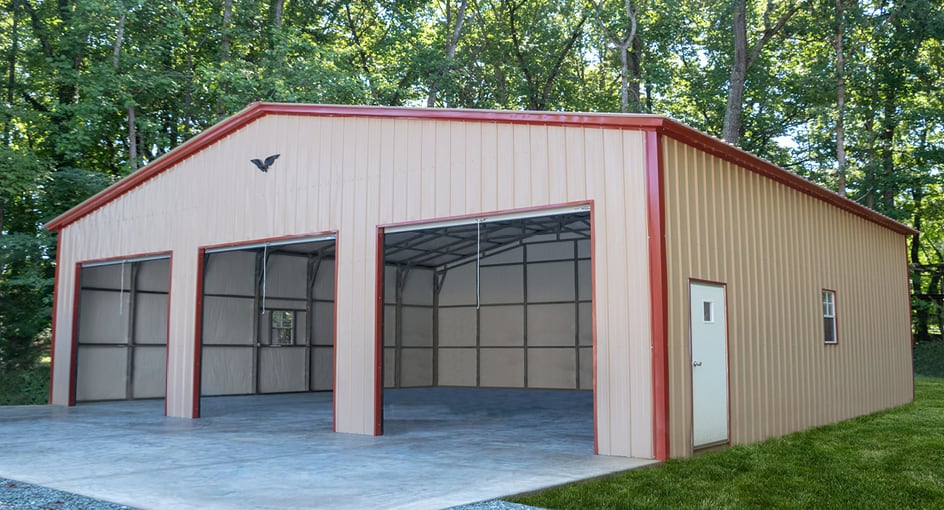No matter where you live in the United States, there are natural disasters to remind you to get insurance for your properties. Combining through the plethora of available insurance plans may seem overwhelming and quite expensive, but there are ways that you can reduce your insurance premiums.
Metal buildings can decrease insurance premiums by up to 40% compared to traditional wood buildings. Unlike wood, steel is considered a fireproof material, which means that it will not catch on fire, or it will burn slowly.
You may be wondering if metal buildings are worth the investment. Why exactly do metal buildings decrease insurance premiums, and what is their resale value? On top of trying to find all that information, you probably have a full schedule of planning and work. Don’t worry. Those questions are all answered right here for your convenience.
Why Metal Buildings Can Decrease the Cost of Your Insurance Premium
In short, insurance works by using a mixture of the law of large numbers and probability. By setting a standard for risk categories, they can estimate how much of a liability, or risk, they’d take by covering your property.
Buildings are ranked in six classifications from Construction Class 1 (the least fire-resistant and higher risk level) to Construction Class 6 (the most fire-resistant and lower risk level), as defined in the chart below:
| Construction Class | Type | Characteristics |
| CC 1 | Frame | – Exterior walls of non-combustible or slow-burning material- Combustible floors, walls, and roof- Roofs with both combustible and non-combustible material |
| CC 2 | Joined Masonry | – Exterior walls made with fire-resistant material- Fire-resistant material rated at not less than one hour- Combustible floors and roof |
| CC 3 | Non-combustible (Includes most metal buildings) | – Construction workers build exterior walls, floors, and roof with non-combustible material or slow-burning material- May include non-combustible or slow-burning supports |
| CC 4 | Masonry Non-combustible | – Exterior walls constructed with fire-resistant material ranked not less than one hour- Masonry is four or more inches thick- Non-combustible or slow-burning floors and roof |
| CC 5 | Modified Fire Resistive | – Exterior walls, floors, and roof made with fire-resistant material rated not less than 1 hour but under 2 hours- Minor deficiencies compared to CC6 |
| CC 6 | Fire-Resistive | -Solid masonry walls four or more inches thick or hollow masonry walls 8 inches or thicker- Fire-resistance rating is two or more hours in walls, roof, and floor- Pre-stressed or post-tensioned concrete- Fire-resistant metal supports |
Mixed-Class Buildings
Most buildings are created with several classes’ characteristics and will usually fall into the riskier category depending on the percentage of material used in each class. If the building is built and has over 33.33% of a lower construction class, insurance providers will classify it in the riskier category.
Example: A structure is built using 66.5% Non-combustible (CC3) and 33.5% Joined Masonry (CC2), the building will be a CC2.
Insurance providers will classify buildings based on the higher risk category because once a high-risk element, like combustible material, is introduced, the whole structure becomes compromised.
Resale Value of Metal Buildings
Not only is building with metal a sturdier option, but it’s also more affordable than traditional buildings. According to CDMG, choosing to build with steel adds value because people relate steel buildings with new construction.
So, not only does adding a metal building help decrease your insurance premium, but it can also help increase your property value for a reasonable cost.
Imagine a beautiful one-story home on the market—it has everything you want but no garage. A similar house is on the market and also has a garage. You notice the home’s price with the garage is about 20-30 thousand more but decide that you’d rather store your motorcycle in your garage and keep your car out of the rain or snow. Just by adding the garage, the home’s value is significantly increased.
How to Find Lower Insurance
You now know that building with metal can lead to a lower insurance premium, but you can also invest in some specific design features that can help reduce your rates even more. Who doesn’t love discounts?
- Disaster-Proof Your Home- This means adding anything from storm shutters to reinforcing your roof. You can also upgrade your electrical system, plumbing, and heating to reduce fire or water damage.
- Invest in Home Security- Purchase burglar alarms, smoke detectors, deadbolts, and sprinkler systems. Most homes have the minimum required smoke detectors, but you can always add sprinklers and security systems to cut back on your insurance and protect your home.
To Sum Up
In the long run, metal buildings help decrease insurance premiums due to their moderate ranking, low costs, and sturdy builds. Metal buildings can improve your home’s value and be a cost-effective way to upgrade or construct a new building
Remember: when you’re looking to lower your insurance premium, investing in particular design specifications can help you qualify for more discounts with your insurance provider.


